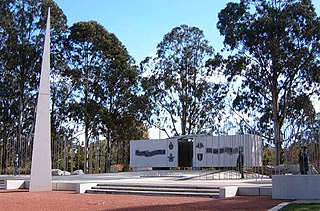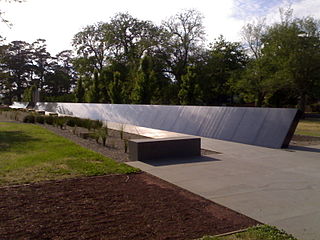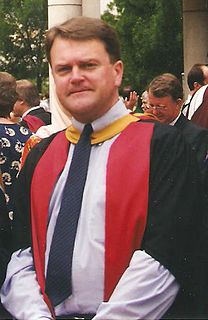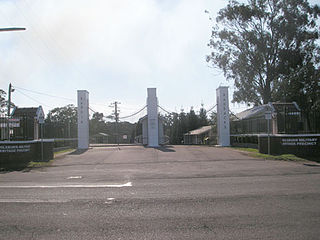Design
Three concrete stelae, rising from a shallow moat, form the dramatic centre and enclose a space for quiet contemplation.
A low stone block is both a seat and a place for laying memorial tributes.
Fixed to the right wall are 33 inscriptions, quotations intended to recall events of military and political importance. The memorial features a photograph by Australian Army photographer Mike Coleridge - Members of 5 Platoon, B Company, 7th Battalion, The Royal Australian Regiment, 26 August 1967 The photograph, etched on the rear wall, shows soldiers waiting to be airlifted to the Australian base at Nui Dat after Operation Ullmarah. The walls offer anchors for wires that suspend a halo of stones: A scroll containing the names of Australians who died in Vietnam is sealed into one of the stones.
Six seats surround the memorial, each dedicated to an Australian serviceman missing in action in Vietnam.
The memorial was designed by Tonkin Zulaikha Harford in association with sculptor Ken Unsworth AM, and built largely from funds donated from the public to the Australian Vietnam Forces National Memorial Committee.

The Vietnam Veterans Memorial is a U.S. national memorial in Washington, D.C., honoring service members of the U.S. armed forces who fought in the Vietnam War. The 2-acre (8,100 m2) site is dominated by a black granite wall engraved with the names of those service members who died as a result of their service in Vietnam and South East Asia during the war. The wall, completed in 1982, has since been supplemented with the statue The Three Soldiers and the Vietnam Women's Memorial.

A cenotaph is an empty tomb or a monument erected in honour of a person or group of people whose remains are elsewhere. It can also be the initial tomb for a person who has since been reinterred elsewhere. Although the vast majority of cenotaphs honour individuals, many noted cenotaphs are instead dedicated to the memories of groups of individuals, such as the lost soldiers of a country or of an empire.

The Australian War Memorial is Australia's national memorial to the members of its armed forces and supporting organisations who have died or participated in wars involving the Commonwealth of Australia and some conflicts involving personnel from the Australian colonies prior to Federation. Opened in 1941, the memorial includes an extensive national military museum.

A war memorial is a building, monument, statue, or other edifice to celebrate a war or victory, or to commemorate those who died or were injured in a war.

The Australian and New Zealand Army Corps (ANZAC) was a First World War army corps of the Mediterranean Expeditionary Force. It was formed in Egypt in December 1914, and operated during the Gallipoli campaign. General William Birdwood commanded the corps, which primarily consisted of troops from the First Australian Imperial Force and 1st New Zealand Expeditionary Force, although there were also British and Indian units attached at times throughout the campaign. The corps disbanded in 1916, following the Allied evacuation of the Gallipoli peninsula and the formation of I ANZAC Corps and II ANZAC Corps. The corps was reestablished, briefly, in the Second World War during the Battle of Greece in 1941.

The Australian Army Training Team Vietnam (AATTV) was a specialist unit of military advisors of the Australian Army that operated during the Vietnam War. Raised in 1962, the unit was formed solely for service as part of Australia's contribution to the war, providing training and assistance to South Vietnamese forces. Initially numbering only approximately 30 men, the size of the unit grew several times over the following years as the Australian commitment to South Vietnam gradually grew, with the unit's strength peaking at 227 in November 1970. Members of the team worked individually or in small groups, operating throughout the country from the far south to the Demilitarized Zone (DMZ) in the north. Later they were concentrated in Phước Tuy Province as Australian forces prepared to withdraw from Vietnam. It is believed to be the most decorated Australian unit to serve in Vietnam; its members received over 100 decorations, including four Victoria Crosses, during its existence. The unit was withdrawn from Vietnam on 18 December 1972 and was disbanded in Australia on 16 February 1973. A total of 1,009 men served with the unit over a period of ten years, consisting of 998 Australians and 11 New Zealanders.

The Royal Australian Air Force Memorial is on Anzac Parade, the principal ceremonial and memorial avenue of Canberra, the capital city of Australia.

The Rats of Tobruk Memorial is on Anzac Parade, the principal ceremonial and memorial avenue of Canberra, Australia.

The Australian National Korean War Memorial is on Anzac Parade, the principal ceremonial and memorial avenue in Canberra, the national capital city of Australia.

ANZAC Square is a heritage-listed town square and war memorial located between Ann Street and Adelaide Street, in Brisbane, Queensland, Australia. It is a state memorial to the men and women who participated in overseas armed service and is named in honour of the Australian and New Zealand Army Corps. ANZAC Square is adjacent to ANZAC Square Arcade.

The 3rd Battalion, The Royal Australian Regiment is a mechanised infantry battalion of the Australian Army, based in Kapyong Lines, Townsville as part of the 3rd Brigade. 3 RAR traces its lineage to 1945 and has seen operational service in Japan, Korea, Malaya, Borneo, South Vietnam, Rifle Company Butterworth, East Timor, the Solomon Islands, Afghanistan and Iraq.

Cambridge American Cemetery and Memorial is a World War II American military war grave cemetery, located between the villages of Coton and Madingley, 7 km (4.3 mi) north-west of Cambridge, England. The cemetery, dedicated in 1956, contains 3,811 American war dead and covers 30.5 acres (12.3 ha). Cambridge American Cemetery is one of 26 overseas military cemeteries administered by the American Battle Monuments Commission (ABMC).

Australia's involvement in the Vietnam War began with a small commitment of 30 military advisors in 1962, and increased over the following decade to a peak of 7,672 Australian personnel following the Menzies Government's April 1965 decision to upgrade its military commitment to South Vietnam's security. By the time the last Australian personnel were withdrawn in 1972, the Vietnam War had become Australia's longest war, eventually being surpassed by Australia's long-term commitment to the War in Afghanistan. It remains Australia's largest force contribution to a foreign conflict since the Second World War, and was also the most controversial military action in Australia since the conscription controversy during World War I. Although initially enjoying broad support due to concerns about the spread of communism in Southeast Asia, an increasingly influential anti-war movement developed, particularly in response to the government's imposition of conscription.

Cathedral Church of St Michael and St George serves as the Roman Catholic cathedral for the Bishopric of the Forces. Located on Queens Avenue in Aldershot, England, the building was originally intended to be the principal church for the Anglican chaplaincies of the British Army but since 1973 it has been the seat of the Roman Catholic Bishop of the Forces.

The Australian Ex-Prisoners of War Memorial was dedicated on Friday, 6 February 2004. It is located on the southern approaches to the Ballarat Botanical Gardens, on Wendouree Parade and adjacent to Lake Wendouree.

General Sir John Gordon Noel Wilton, was a senior commander in the Australian Army. He served as Chief of the General Staff (CGS), the Army's professional head, from 1963 until 1966, and as Chairman of the Chiefs of Staff Committee (CCOSC), forerunner of the role of Australia's Chief of the Defence Force, from 1966 until 1970. His eight-year tenure as senior officer of first the Army and then the Australian military spanned almost the entire period of the nation's involvement in the Vietnam War.

Blue Beach Military Cemetery at San Carlos is a British war cemetery in the Falkland Islands holding the remains of 13 of the 255 British casualties killed during the Falklands War in 1982, and one other killed in early 1984. It is situated close to where 3 Commando Brigade had its initial headquarters after landing on 21 May 1982.

Jeffrey Guy Grey was an Australian military historian. He wrote two volumes of The Official History of Australia's Involvement in Southeast Asian Conflicts 1948–1975, and several other high-profile works on Australia's military history. He was the first non-American to become the president of the Society for Military History, but is perhaps best known as the author of A Military History of Australia.

Ingleburn Military Heritage Precinct and Mont St Quentin Oval is a heritage-listed conservation area at the site of the former Ingleburn Army Camp at Campbelltown Road, Ingleburn, Sydney, New South Wales, Australia. The heritage buildings on site were built from 1939. It was added to the New South Wales State Heritage Register on 15 March 2013.





















